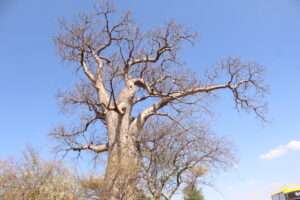By Dennis Mutua

A Baobab tree at Mirambani area in Tharaka | PHOTO-Dennis Mutua
In the vast semi-arid of Tharaka land, giant baobab trees are common features mostly growing freely in the bushes free from human activities interruption.
According to information available online, baobab trees have 9 species and have a life span of up to 1500 years which allows them to grow into gigantic trees producing fruits referred to as Monkey bread, compared to other trees in arid and semi-arid places.
However unknown to many, traditionally in Tharaka the trees were highly valued and treasured due to their multiple uses in the then community which made them
an economic booster in the areas where they grew.
According to mzee Mwabu who spoke to The Eastern Newspaper, Baobab trees were referred to in the local Tharaka dialect as Mbuuba Ukea which translates to a tree of life from the many benefit that the community got from the trees.
To begin with, Mzee Mwabu says the powder extracted from baobab tree fruits, was used as food where it was mixed with milk and drunk, or alternatively, the powder would also be taken dry especially by herders while in the bushes.
The dry pods of monkey bread were too used as calabash mostly by herders to milk animals while they grazed in the bushes.
Flowers from the trees before they developed into fruits commonly known as Makwatha was chewed while fibres from the barks known as Maguna was also chewed. In the case of fibres, the barks were cut and exposed fibres extracted.
The same fibres were used in weaving activities to produce strong ropes used to tether animals as they grazed around. Also, the ropes weaved from the fibres was also vital for beekeepers to hold beehives when hanging them on top of tall trees.
Mzee Mwabu further told The Eastern Newspaper, that the fibres were woven to make traditional clothing for men worn by men on the waistline to cover the rear and front below the waist.
These fibres from baobab were also highly valued by women who used them to make long thin and fines fibres referred to as Nyenje which were then used to weave sizeable Ciondos and huge ones called Nkaranga used for harvesting of crops and storage of the same.
For the hunters, the baobab tree was used for security purposes where they clung to the branches at night to stay away from marauding dangerous wild animals to avoid being injured as they rested. The same trees provided shade during hot days from their extended branches.
Monkey bread seeds were also a source of oil. The Eastern Newspaper established that the seeds were cracked and the fatty corn is eaten for its nutrition value. Additionally, the oil could be extracted and used to prepare nose sniffing tobacco highly valued by the elderly to date.
Traditional herbalists got medicinal value from the freely growing trees around. Mwabu revealed that the barks of the succulent trees were cut, scrubbed, and then boiled and the extract was used to heal stomach discomforts and infant pneumonia.
From the battery of uses realized on the baobab tree, the elders of then, therefore, had a reason to believe that indeed baobab was a tree of life that was used to dispel poverty as its name suggested in the local kitharaka dialect.
According to Mwabu, baobab trees grew in the bushes where human interruption was minimal considering that their leaves are grazed on by animals which would hamper their growth into big trees.
Their seeds would then be distributed to different areas through the animals like monkeys who fed on monkey bread in the arid bushes of Tharaka.
In the modern world, the breads are still taken raw by the communities where baobab trees grow however they are further processed and added flavors and colors, and stocked in shops for selling.
Although the number of baobab trees is going down day by day, the trees are still evident in large numbers in different areas of Tharaka like in Kiamiramba in Tharaka North Sub County which is named after the baobab trees.




